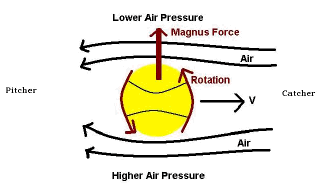|
by Gerald Warner,
Softball Pitching Instructor

There
has long been differing opinions between fastpitch softball players
vs. die-hard students of physics and aerodynamics as to whether a
properly thrown rise ball can overcome the gravitational force
trying to pull it downward, enough to really
RISE.
The
author of this article, Gerald
Warner, is a longtime softball addict who
didn’t gain much from his Physical Science minor in college…so
he has had to gain this information during the past several
years from people who are a lot wiser. Our thanks to Jaclyn
Parlo and Armstrong
Atlantic
University’s Physics
Department, Gustav Magnus, Angie Triplett and The College of
Wooster Physics
Department, and many
others.
|
As
we have mentioned in other articles on this website, the majority of
young pitchers who have been told or “think” they can throw a rise
ball do NOT:
- Release
the ball with correct backspin (top-to-bottom as seen by the
catcher)
- Impart
fast enough spin speed (at least 23 to 25 revolutions per
second)
- Pitch
the ball fast enough (mid-50’s at a
minimum)
…so
MOST pitchers are not yet able to throw a truly effective rise
ball.
(More
information on the correct techniques for throwing a rise ball are
on this website at: Rise Ball
Secrets )
Although
most of us pitching instructors, pitchers, hitters, coaches, and
parents feel that we have seen rise balls “hop” over the top of a
bat, there is no scientific evidence to prove that a softball can be
thrown with sufficient speed and backspin to make an upward arc in
its trajectory.
Many of us have flicked a table tennis ball to make it
dramatically curve, drop, and even rise. However, it has been
estimated that a 6.8 ounce softball would have to be thrown at over
90 mph with a spin speed in excess of 35 revolutions per second in
order to give the ball even a minor upward arc.
So…
A “RISE BALL”, EVEN WHEN THROWN CORRECTLY, DOES NOT
RISE…
it
simply falls slower than a similar speed fastball that doesn’t have
backspin and therefore has a more level plane on its path to the
plate. Although the example below is exaggerated to show
a more dramatic arc than what is actually less curved on a 60 mph
fastball, look at the comparison:

However,
because the ball doesn’t have the same gravitational drop as most
batters expect, the batter perceives the rise ball to "jump" over
the bat... and even major league baseball players have been unable
to make contact with a well thrown rise ball from a female
pitcher.
THE
MAGNUS EFFECT
- Although there are many factors that contribute to the success of
any “breaking” pitch, the easiest for most of us to
understand is that the spinning seams on the ball “dig into” the
air, causing it to move up, down, or sideways more than a ball that
is thrown without the same spin. The principle known as
the Magnus Effect (or
Magnus Force) lowers the air pressure on one side of a spinning
softball, creating low pressure (essentially a slight vacuum), and
causing the ball to either move in a specific direction or, in the
case of a rise ball, remain in the air for a longer distance and
therefore not dropping as much in the trip from the pitcher’s hand
to the batter.

______________________________________________________________
This article above can be downloaded and
printed from Microsoft Word

Do you want to reprint this article or use it
on your website or in your newsletter?
As long
as it is not for profit, our only requirement is that you first
notify us, then include the following sentence:
Article by Gerald Warner of
PitchSoftball.com
and include a reference to this
website: www.pitchsoftball.com
If you have questions or
need more information
E-mail us, or
call Pitching Instructor Gerald Warner in Colorado at
(720) 200-4575
PitchSoftball Home Page | About Us | Beginning Pitchers | 1st & 2nd Year
Pitchers | Advanced Pitchers | Coaches and Parents
Recent Questions and
Recommendations | Search by Keywords | 












